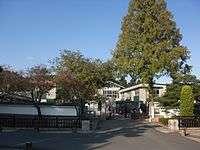Matsuoka Domain

Matsuoka Domain (松岡藩 Matsuoka-han), also known as Hitachi-Matsuoka Domain (常陸松岡藩 Hitachi-Matsuoka-han) was a feudal domain under the Tokugawa shogunate of Edo period Japan, located in Hitachi Province (modern-day Ibaraki Prefecture), Japan. It was centered on Matsuoka Castle in what is now the city of Takahagi, Ibaraki. With the exception of its first twenty years, was ruled by the Nakayama clan.
History
Following the Battle of Sekigahara, in 1600, Tokugawa Ieyasu shifted the Satake clan from its ancestral territories in Hitachi Province to Dewa Province in northern Japan. In 1602, he awarded a portion of the former Satake lands to Tozawa Masamori, marking the start of Matsuoka Domain. He served in a number of important posts within the administration of the Tokugawa shogunate, and was subsequently transferred to Shinjō Domain in Dewa Province in 1622. Matsuoka Domain was divided, with 30,000 koku going to Mito Domain and 10,000 koku to Tanagura Domain.
In 1646, the hereditary karō of Mito Domain, Nakayama Nobumasa, established his residence at Matsuoka. His son, Nakayama Nobuyoshi was confirmed under Tokugawa Yorifusa, to have holdings of 20,000 koku as a subsidiary domain of Mito Domain.
The 6th daimyo of Matsuoka, Nakayama Nobutoshi, moved his residence to Ōta, and the domain was then referred to as Hitachiōta Domain (常陸太田藩 Hitachiōta-han). His descendants continued to reside at Ōta until the time of the 10th daimyo, Nakayama Nobutaka, who returned the seat of the clan back to Matsuoka. During the Boshin War, the 14th daimyo, Nakayama Nobuaki, sided with the pro-Imperial forces, and after the Meiji restoration in 1868, Matsuoka Domain was finally recognized as independent of Mito Domain. The following year, the position of daimyo was abolished, and Nakayama Nobuaki became domain governor until the abolition of the han system in 1871.
The domain had a total population of 12,805 people in 2842 households per a census in 1869.[1]
Holdings at the end of the Edo period
Unlike most domains in the han system, Matsuoka Domain consisted of a single territory calculated to provide the assigned kokudaka, based on periodic cadastral surveys and projected agricultural yields.[2][3]
- Hitachi Province
- 29 villages in Taga District
List of daimyō
| # | Name | Tenure | Courtesy title | Court Rank | kokudaka | |
|---|---|---|---|---|---|---|
| 1 | Tozawa Masamori (戸沢政盛) | 1602-1622 | Ukyo-no-suke (右京亮) | Lower 5th (従五位下) | 40,000 koku | |
| 1 | Nakayama Nobuyoshi (中山信吉) | 1622-1642 | Bizen-no-kami (備前守) | Lower 5th (従五位下) | 25,000 koku | |
| 2 | Nakayama Nobumasa (中山信政) | 1642–1651 | Higashi-ichi-no-kami (東市正) | Lower 5th (従五位下) | 25,000 koku | |
| 3 | Nakayama Nobuharu (中山信治) | 1651-1681 | Bizen-no-kami (備前守) | Lower 5th (従五位下) | 25,000 koku | |
| 4 | Nakayama Nobuyuki (中山信行) | 1681-1682 | Ichi-no-kami (市正) | Lower 5th (従五位下) | 25,000 koku | |
| 5 | Nakayama Nobunari (中山信成) | 1683-1703 | Bizen-no-kami (備前守) | Lower 5th (従五位下) | 25,000 koku | |
| 6 | Nakayama Nobutoshi (中山信敏) | 1703-1711 | Bizen-no-kami (備前守) | Lower 5th (従五位下) | 25,000 koku | |
| 7 | Nakayama Nobuyori (中山信順) | 1711-1712 | Ichi-no-kami (市正) | Lower 5th (従五位下) | 25,000 koku | |
| 8 | Nakayama Nobumasa (中山信昌) | 1712-1743 | Bizen-no-kami (備前守) | Lower 5th (従五位下) | 25,000 koku | |
| 9 | Nakayama Masanobu (中山政信) | 1743-1771 | Bizen-no-kami (備前守) | Lower 5th (従五位下) | 25,000 koku | |
| 10 | Nakayama Nobutaka (中山信敬) | 1771-1819 | Bitchu-no-kami (備中守) | Lower 5th (従五位下) | 25,000 koku | |
| 11 | Nakayama Nobumoto (中山信情) | 1819-1828 | Bitchu-no-kami (備中守) | Lower 5th (従五位下) | 25,000 koku | |
| 12 | Nakayama Nobumori (中山信守) | 1828-1857 | Bingo-no-kami (備後守) | Lower 5th (従五位下) | 25,000 koku | |
| 13 | Nakayama Nobutomi (中山信宝) | 1857-1861 | Bizen-no-kami (備前守) | Lower 5th (従五位下) | 25,000 koku | |
| 14 | Nakayama Nobuaki (中山信徴) | 1857-1861 | Bitchu-no-kami (備中守) | Lower 5th (従五位下) | 25,000 koku | |
References
- Papinot, E (1910). Historical and Geographic Dictionary of Japan. Tuttle (reprint) 1972.
External links
- (Japanese) Matsuoka on "Edo 300 HTML"
Notes
- ↑ Edo daimyo.net (Japanese)
- ↑ Mass, Jeffrey P. and William B. Hauser. (1987). The Bakufu in Japanese History, p. 150.
- ↑ Elison, George and Bardwell L. Smith (1987). Warlords, Artists, & Commoners: Japan in the Sixteenth Century, p. 18.